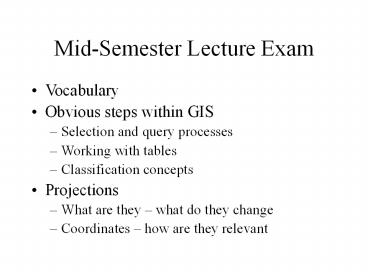Mid-Semester Lecture Exam - PowerPoint PPT Presentation
Title:
Mid-Semester Lecture Exam
Description:
Mid-Semester Lecture Exam Vocabulary Obvious steps within GIS Selection and query processes Working with tables Classification concepts Projections – PowerPoint PPT presentation
Number of Views:231
Avg rating:3.0/5.0
Title: Mid-Semester Lecture Exam
1
Mid-Semester Lecture Exam
- Vocabulary
- Obvious steps within GIS
- Selection and query processes
- Working with tables
- Classification concepts
- Projections
- What are they what do they change
- Coordinates how are they relevant
2
Home Work 1
Dealing with an exchange format
- In ArcToolBox
- Coversion Tools
- Import to coverage
- Import from interchange file
- Define projection for coverage
- In ArcMap
- Data
- Export to shapefile
- Project shapefile to whatever you want
3
- Data types raster vs. vector
- How does GIS differ from a mapping or CAD package
- The three basic components of ArcGIS
- Define vs Projection
- Metadata
- More questions about coordinates
- What information is critical for a coordinates to
be relevant? - Cardinality
- When do you use a join and when relate?
4
Tables Continued
- Adding Fields and Records
5
There are several data types
- There are two basic types common used
6
Data Types
It is very important to choose the right data
type.
7
ArcGIS can handle several tabular data formats
- Coverages use an INFO format. These are an older
format, cumbersome, but still frequently used. - A shapefile uses a .dbf format. Much more
sophisticated than an INFO file. We are
currently using .dbf files in the lab exercises. - Geodatabases uses a RDBMS format. Very
sophisticated and powerful but more complex. We
will use them in a few weeks time.
8
Very often you need a new field in a table.
9
Specify the Name and the Data Type
Integers No Decimals
-32,000 to 32,000
-2 billion to 2 billion
10
Numbers with Decimal Places
Precision is the number of digits to be stored.
Scale is the number of decimal places.
11
Date
Text
It is important to specify a length to
accommodate your attribute but not too long.
12
Calculating a Value
13
(No Transcript)
14
The selected records are assigned the calculated
value
Notice that text values are enclosed in double
quotes
15
Calculating a Numeric
16
Convert from one data type to a different data
type
Text type
Numeric type
17
Add a new numeric FIPS field then calculate the
text field as a numeric field.
18
Create a New Table
19
(No Transcript)
20
Open the new table in ArcMap and then add data
21
You can use ascii files































